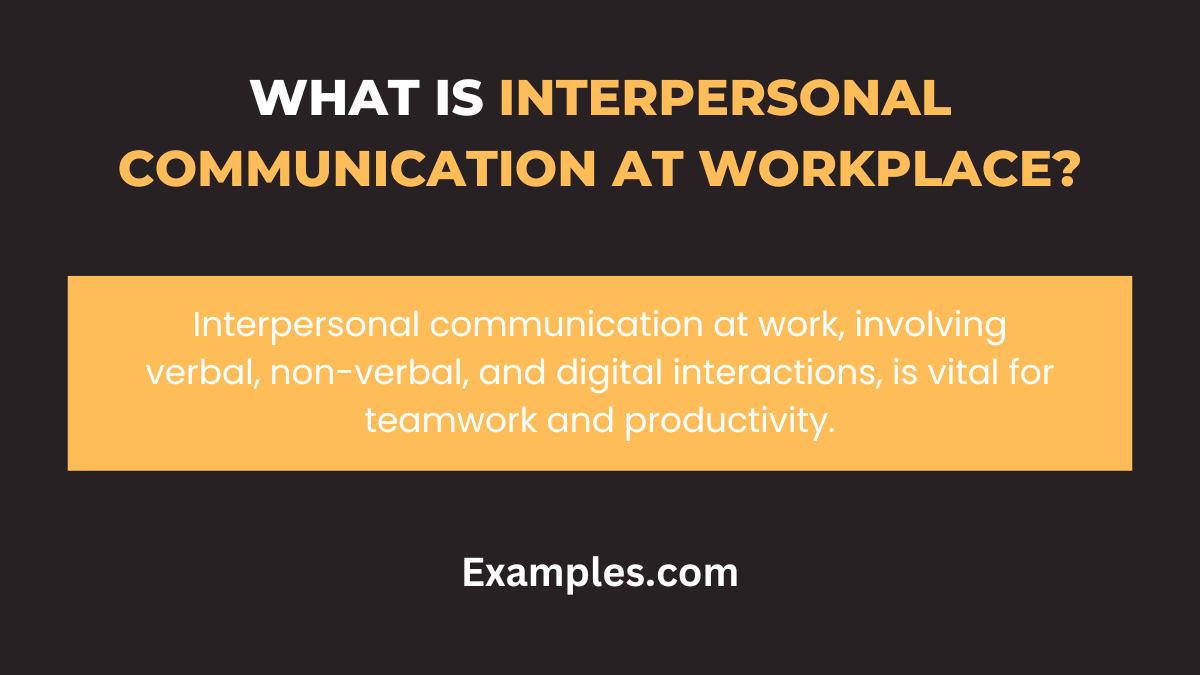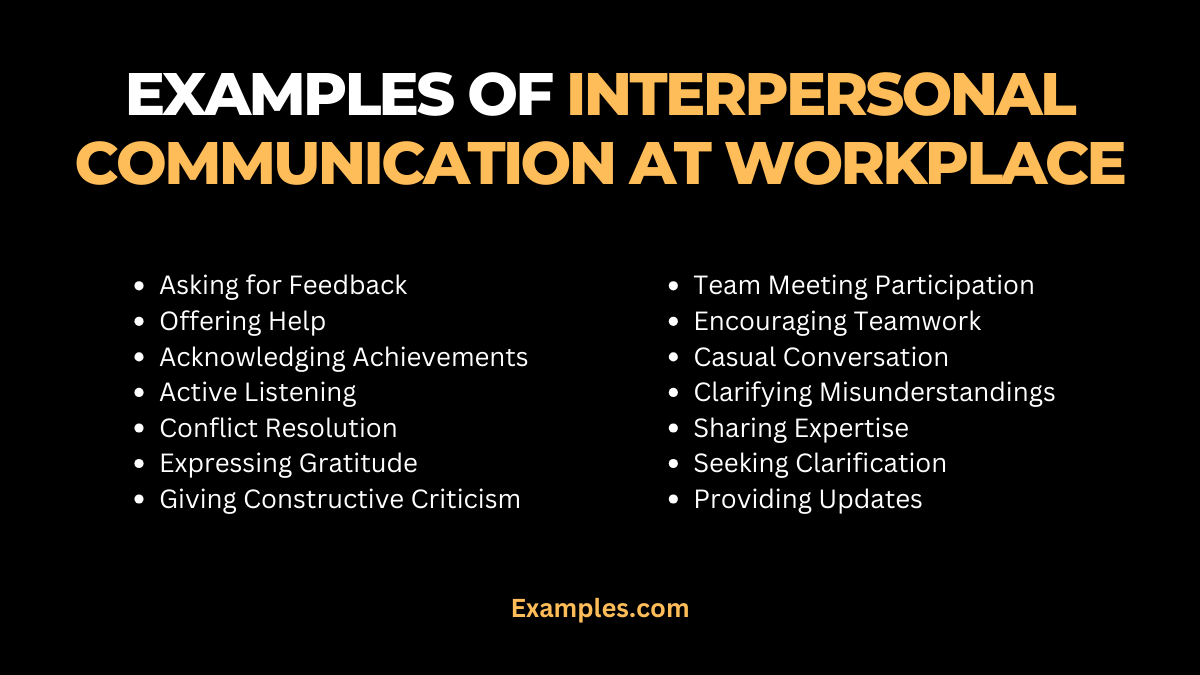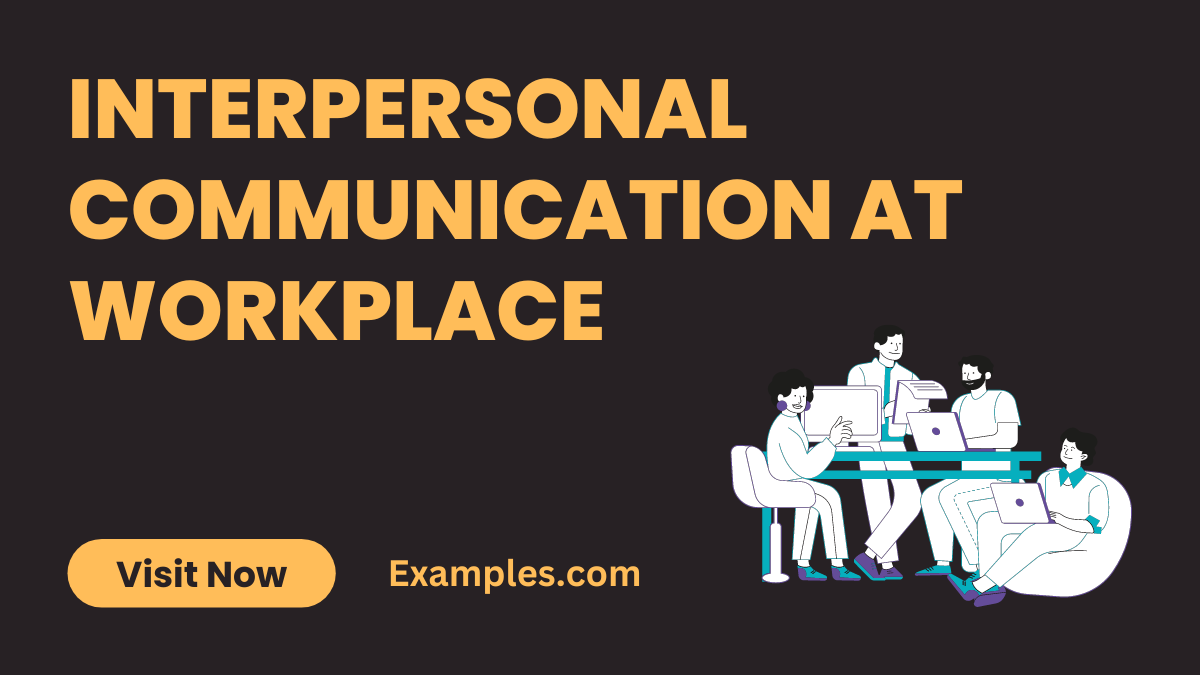13+ Interpersonal Communication at Workplace Examples
Effective interpersonal communication at the workplace is pivotal for fostering a cohesive and productive environment. Incorporating oral communication seamlessly into daily interactions ensures clarity and understanding among team members. It involves more than just the exchange of words; it’s about understanding the emotional expressions and non-verbal signals that accompany those words. Mastering this art leads to better team dynamics, improved problem-solving, and a more enjoyable workplace culture.
What is Interpersonal Communication at Workplace? – Definition

Interpersonal communication at the workplace refers to the process of exchanging information, ideas, and feelings between colleagues within a professional setting. This exchange can take various forms, such as verbal communication, non-verbal cues, written messages, and digital interactions. It’s not just about what is communicated, but how it is conveyed and received. Effective interpersonal communication is key to building strong work relationships, facilitating teamwork, and enhancing overall workplace productivity.
Examples of Interpersonal Communication at Workplace

Effective interpersonal communication at the workplace is essential for creating a positive and productive environment. It encompasses various aspects, including verbal, non-verbal, and digital communication, ensuring clarity and mutual understanding among team members. This dynamic process is vital for collaboration, conflict resolution, and fostering strong professional relationships.
- Asking for Feedback: “Could you provide your thoughts on this report? I value your perspective.”
- Offering Help: “I noticed you’re working on the annual budget. Do you need any assistance with that?”
- Acknowledging Achievements: “Great job on the presentation, your hard work really paid off!”
- Active Listening: “I understand that this project is challenging. What can we do to make it easier?”
- Conflict Resolution: “Let’s discuss this issue and find a solution that works for both of us.”
- Expressing Gratitude: “Thank you for staying late yesterday to help with the project.”
- Giving Constructive Criticism: “Your report was very informative, but adding more data might enhance its impact.”

- Team Meeting Participation: “I have some ideas on how we can improve our workflow.”
- Encouraging Teamwork: “Let’s collaborate on this project to bring diverse ideas together.”
- Casual Conversation: “How was your weekend? I hope you had a chance to relax.”
- Clarifying Misunderstandings: “I wanted to clarify what I meant in yesterday’s meeting.”
- Sharing Expertise: “Based on my experience, this approach might be more effective.”
- Seeking Clarification: “Could you elaborate on that point a bit more?”
- Providing Updates: “I’ve just finished the analysis and here are the key findings.”
- Discussing Work-Life Balance: “It’s important to find a balance. How do you manage your workload?”

Elements of Interpersonal Communication at Workplace
Understanding the elements of interpersonal communication at the workplace is crucial for effective interaction. These elements include:
- Sender and Receiver: The individuals involved in the communication process, where one conveys information and the other receives and interprets it.
- Message: The content of the communication, which can be in verbal, non-verbal, or written form.
- Channel: The medium through which the message is conveyed, such as face-to-face conversations, emails, or digital platforms.
- Feedback: The response of the receiver, providing insight into how the message was interpreted and received.
- Context: The environment or situation in which the communication takes place, influencing the tone and style of interaction.
- Noise: Any external or internal factors that can disrupt or distort the message, such as physical distractions or personal biases.
- Emotional Intelligence: The ability to understand and manage one’s emotions and those of others, crucial in emotional expression and listening.
- Cultural Awareness: Recognizing and respecting cultural differences in communication styles and preferences.
- Body Language: An important aspect of non-verbal communication, including gestures, facial expressions, and posture.
- Tone of Voice: In verbal communication, the tone can convey emotions and attitudes more effectively than words alone
Why Interpersonal Communication is Key in the Workplace
Interpersonal communication is the cornerstone of a thriving workplace. It goes beyond mere exchange of words; it’s about building relationships, understanding emotions, and conveying ideas effectively. In the workplace, effective communication fosters a culture of collaboration and mutual respect, essential for team success.
- Promotes Collaboration and Teamwork: Clear communication among colleagues enhances teamwork and collaboration. It ensures that everyone is on the same page, leading to efficient and cohesive work processes.
- Facilitates Problem-Solving: When issues arise, effective interpersonal communication helps in identifying and resolving problems swiftly. Open communication channels encourage team members to share concerns and work together towards solutions.
- Enhances Employee Morale: Positive communication contributes to a supportive work environment. Acknowledging achievements, providing constructive feedback, and maintaining respectful interactions boost employee morale and job satisfaction.
- Improves Management-Employee Relations: Transparent communication between management and staff is vital. It helps in setting clear expectations, providing guidance, and fostering a sense of belonging and value among employees.
- Aids in Conflict Resolution: Inevitable workplace conflicts are more efficiently resolved through effective communication. Understanding different viewpoints and finding common ground is key in maintaining a harmonious work environment.
- Supports Professional Growth: Regular feedback and open discussions about career goals and performance help employees in their professional development, aligning their growth with organizational objectives.
How to Improve Interpersonal Communication at Workplace
Enhancing interpersonal communication at the workplace can significantly improve productivity and employee relations. Here’s how to achieve it:
- Develop Active Listening Skills: Listen to understand, not just to respond. Pay attention to what is being said and show interest. Active listening involves engaging with the speaker, asking clarifying questions, and summarizing their points to ensure understanding.
- Practice Clear and Concise Communication: Be clear and direct in your communication. Avoid jargon or complex language that might lead to misunderstandings. Simplicity ensures your message is understood by all.
- Cultivate Emotional Intelligence: Recognize and understand your emotions and those of others. This sensitivity helps in navigating conversations tactfully, especially in delicate situations.
- Encourage Open Dialogue: Create an environment where team members feel comfortable sharing ideas and concerns. Open dialogue promotes innovation and problem-solving.
- Respect Cultural Differences: In today’s diverse workplaces, being aware of and respectful towards different cultural communication styles is important for interpersonal communication.
- Use Positive Body Language: Non-verbal cues like eye contact, nodding, and open posture can greatly enhance the effectiveness of your communication.
- Provide Constructive Feedback: Offer feedback that is specific, helpful, and focused on behavior rather than personal attributes. This approach is more likely to be received positively and lead to improvement.
- Regularly Check-in with Colleagues: Regular interactions help in building trust and understanding, vital components of effective workplace communication.
- Utilize Technology Effectively: In the era of digital communication, using tools like email, instant messaging, and video conferencing can enhance and streamline communication.
- Engage in Continuous Learning: Attend workshops, read books, and seek feedback on your communication skills. Continuous learning is key to improving and adapting your communication style to meet the evolving demands of the workplace.
Effective interpersonal communication is essential in the workplace. By following the guide and tips provided, you can navigate workplace interactions with confidence. Clear communication fosters collaboration, resolves conflicts, and enhances professional relationships. Practice active listening, empathy, and assertiveness to excel in your career and create a harmonious work environment. Mastering these skills is a key to success in any workplace setting.



